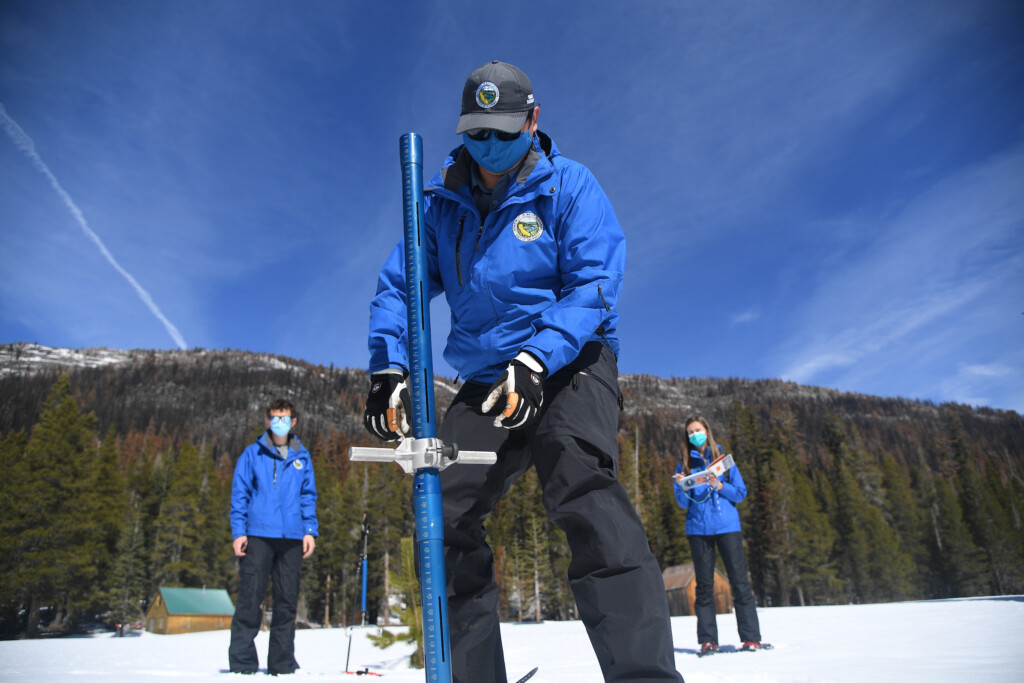Valley Water: Drought will have harsh impact on region
Residents will need to cut back on water uses by 15 percent compared to 2019 levels, says Valley Water
![]()

Photo courtesy of California Department of Water Resources
On March 1, researchers took a snowpack level survey at Phillips Station in the Sierras.
By Marty Cheek
California just experienced three of the driest months on record, meaning the state faces another year of drought. Valley Water officials warn Santa Clara County residents they will need to cut back on water uses by 15 percent compared to 2019 levels.
The state has been in a severe drought for the past three years, and if it continues it will surpass the historic drought lasting from 2012 to 2016. Climate scientists at the University of California, Los Angeles said in a survey released in mid-February the southwestern United States might be now in a “mega-drought” lasting the past 22 years, the worst since at least 800 A.D.
 The end of the 2021/2022 winter season remained dry with minimal snow falling in the Sierra Nevada. The April 1 snowpack survey measured at 38 percent of average. Higher temperatures meant the snowpack melted into water absorbed by dry ground or evaporated into the air. A meager .35 inches of rain fell in San Jose during March. These are grim indications the state’s severe drought will likely worsen in the drier spring and summer months, said Valley Water Board Chair Pro Tem John Varela, who represents the South Valley region.
The end of the 2021/2022 winter season remained dry with minimal snow falling in the Sierra Nevada. The April 1 snowpack survey measured at 38 percent of average. Higher temperatures meant the snowpack melted into water absorbed by dry ground or evaporated into the air. A meager .35 inches of rain fell in San Jose during March. These are grim indications the state’s severe drought will likely worsen in the drier spring and summer months, said Valley Water Board Chair Pro Tem John Varela, who represents the South Valley region.
“The rainfall during January, February and March is critical to our water supply,” he wrote in a Valley Water newsletter. “With just .36 inches of rain combined in 2022, it is the driest start to a calendar year on record.”
In comparison, the region’s average rainfall during the first three months of a typical year is about 7.45 inches. As a result, the region is in a third straight year of drought. The dry conditions across the Golden State are severely impacting water supplies in many communities and farmland.
Santa Clara County receives more than 50 percent of its water supply from outside the county, meaning the region is dependent on sources that are now in dire crisis as the drought grows worse. The State Water Project is changing its water allocation to Valley Water from 15 percent to 5 percent. Valley Water officials learned April 1 water allocation from the federal government’s Central Valley Project was reduced from 25 percent, meaning it is no longer able to provide a set water allocation. It will work with Valley Water to meet minimum public health and safety needs for Santa Clara County. This announcement comes on the heels of the Valley Water has been taking action to protect groundwater basins, especially in the South Valley region where much of the drinking water and agricultural water comes from aquifers. The agency is purchasing emergency water and working to withdraw previously banked supplies. Also, the need to conserve water has never been more critical.
“There’s a finite amount of water and South County is, short of the recycled water that we have, is 100 percent reliant on the ground water that we have there,” said Aaron Baker, chief operating officer of Valley Water’s Water Utility Enterprise. “We need to understand and make certain we’re using that water sustainably as the drought continues.”
As California faces climate change and more severe droughts, Valley Water is investing in its water infrastructure to ensure a reliable water supply, Varela said.
“That includes upgrading and maintaining our pipelines and water treatment plants, evaluating new water storage projects, and expediting the Anderson Dam Seismic Retrofit Project,” he said.
Valley Water is also expanding its water reuse efforts in the South Valley through recycled water technology that can provide millions of gallons per day of high-quality water for drinking and non-drinking purposes. Its goal is to develop recycled and purified water to provide at least 10 percent of the county’s water demands. Using advanced purified water will protect water supply from the impacts of climate change, and together with conservation, will make our future drought-proof.
“The residents of South County are some of the best water conservers that we’ve got,” Baker said. “But we really need to step it up this summer as this drought continues.”
Varela believes conservation must be a way of life for residents in Santa Clara County, especially in reducing outdoor watering in gardens and landscaping. Residents and businesses can take advantage of the agency’s conservation programs by visiting watersavings.org, including receiving substantial rebates to change home and commercial landscaping to cut down on water use.
“We would really like to encourage the commercial/industrial because we look at landscapes from communities such as Big Tech and even schools that have large green spaces,” Varela said. “So drip irrigation can help immensely in saving water for our communities.”
Valley Water plans to increase the use of recycled water throughout Santa Clara County and will soon begin construction on the South County Recycled Water Pipeline project, Varela said.
“This project is another way for us to save drinking water,” he said.
Working in partnership with the city of Gilroy, roughly 3.5 miles of pipeline will be added. This will enhance the current connection to the South County Recycled Water Authority wastewater treatment plant facility, allowing more farms and businesses to have access to this crucial water supply.
The pipeline will reduce the dependency on groundwater to feed the distribution systems for Gilroy, Morgan Hill and San Martin. Recycled water provided to users in Santa Clara County meets or exceeds standards set by state and federal agencies for the various uses of recycled water.
Valley Water received a $5.7 million grant from the United States Bureau of Reclamation.
“This severe drought won’t be the last one,” Varela said. “Investing in water infrastructure and technology is needed to make sure we can always provide safe, clean water here in Santa Clara County.”
